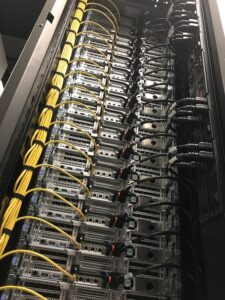 The University of Michigan has selected Dell EMC as lead vendor to supply its new $4.8 million Great Lakes computing cluster, which will serve researchers across campus. Mellanox Technologies will provide networking solutions, and DDN will supply storage hardware.
The University of Michigan has selected Dell EMC as lead vendor to supply its new $4.8 million Great Lakes computing cluster, which will serve researchers across campus. Mellanox Technologies will provide networking solutions, and DDN will supply storage hardware.
Great Lakes will be available to the campus community in the first half of 2019, and over time will replace the Flux supercomputer, which serves more than 2,500 active users at U-M for research ranging from aerospace engineering simulations and molecular dynamics modeling to genomics and cell biology to machine learning and artificial intelligence.
Great Lakes will be the first cluster in the world to use the Mellanox HDR 200 gigabit per second InfiniBand networking solution, enabling faster data transfer speeds and increased application performance.
“High-performance research computing is a critical component of the rich computing ecosystem that supports the university’s core mission,” said Ravi Pendse, U-M’s vice president for information technology and chief information officer. “With Great Lakes, researchers in emerging fields like machine learning and precision health will have access to a higher level of computational power. We’re thrilled to be working with Dell EMC, Mellanox, and DDN; the end result will be improved performance, flexibility, and reliability for U-M researchers.”
“Dell EMC is thrilled to collaborate with the University of Michigan and our technology partners to bring this innovative and powerful system to such a strong community of researchers,” said Thierry Pellegrino, vice president, Dell EMC High Performance Computing. “This Great Lakes cluster will offer an exceptional boost in performance, throughput and response to reduce the time needed for U-M researches to make the next big discovery in a range of disciplines from artificial intelligence to genomics and bioscience.”
The main components of the new cluster are:
- Dell EMC PowerEdge C6420 compute nodes, PowerEdge R640 high memory nodes, and PowerEdge R740 GPU nodes
- Mellanox HDR 200Gb/s InfiniBand ConnectX-6 adapters, Quantum switches and LinkX cables, and InfiniBand gateway platforms
- DDN GRIDScaler® 14KX® and 100 TB of usable IME® (Infinite Memory Engine) memory
“HDR 200G InfiniBand provides the highest data speed and smart In-Network Computing acceleration engines, delivering HPC and AI applications with the best performance, scalability and efficiency,” said Gilad Shainer, vice president of marketing at Mellanox Technologies. “We are excited to collaborate with the University of Michigan, Dell EMC and DataDirect Networks, in building a leading HDR 200G InfiniBand-based supercomputer, serving the growing demands of U-M researchers.”
“DDN has a long history of working with Dell EMC and Mellanox to deliver optimized solutions for our customers. We are happy to be a part of the new Great Lakes cluster, supporting its mission of advanced research and computing. Partnering with forward-looking thought leaders as these is always enlightening and enriching,” said Dr. James Coomer, SVP Product Marketing and Benchmarks at DDN.
 Great Lakes will provide significant improvement in computing performance over Flux. For example, each compute node will have more cores, higher maximum speed capabilities, and increased memory. The cluster will also have improved internet connectivity and file system performance, as well as NVIDIA Tensor GPU cores, which are very powerful for machine learning compared to prior generations of GPUs.
Great Lakes will provide significant improvement in computing performance over Flux. For example, each compute node will have more cores, higher maximum speed capabilities, and increased memory. The cluster will also have improved internet connectivity and file system performance, as well as NVIDIA Tensor GPU cores, which are very powerful for machine learning compared to prior generations of GPUs.
“Users of Great Lakes will have access to more cores, faster cores, faster memory, faster storage, and a more balanced network,” said Brock Palen, Director of Advanced Research Computing – Technology Services (ARC-TS).
The Flux cluster was created approximately 8 years ago, although many of the individual nodes have been added since then. Great Lakes represents an architectural overhaul that will result in better performance and efficiency. Based on extensive input from faculty and other stakeholders across campus, the new Great Lakes cluster will be designed to deliver similar services and capabilities as Flux, including the ability to accommodate faculty purchases of hardware, access to GPUs and large-memory nodes, and improved support for emerging uses such as machine learning and genomics.
ARC-TS will operate and maintain the cluster once it is built. Allocations of computing resources through ARC-TS include access to hundreds of software titles, as well as support and consulting from professional staff with decades of combined experience in research computing.
Updates on the progress of Great Lakes will be available at https://arc-ts.umich.edu/greatlakes/.